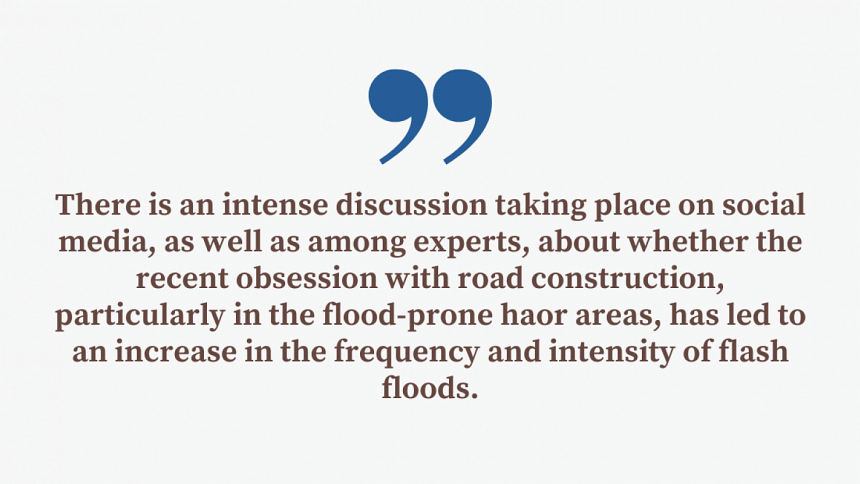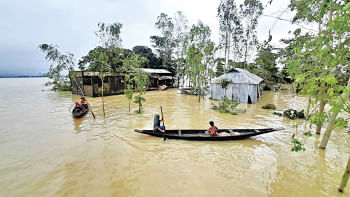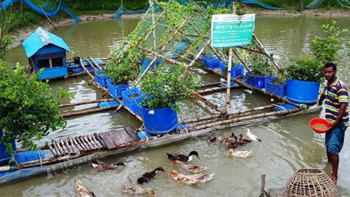Why aren’t we looking at climate-based solutions to address flooding?

The recent floods in Sylhet and the adjoining districts were quite a shock, even though we should have been getting used to this natural disaster by now. Statistics show that in the short span of the last seven years, the country's northern and northeastern regions have witnessed five major floods. Prof Saiful Islam of the Institute of Water and Flood Management (IWFM) in Bangladesh University of Engineering and Technology (Buet) has concluded from 35 years of flooding data that "rains are getting more unpredictable and many rivers are rising above dangerous levels more frequently than before."
Nonetheless, this year's floods and the misery they continue to cause have made us realise that nature still exercises a very powerful influence on our economy and the lives of poor people. While the elite and the political leaders ensconced in Dhaka city celebrate our middle-income status and the opening of the landmark Padma Bridge, for millions affected by the floods in the Sylhet region, the current situation and the future is grim. One is reminded of poet Sukanta Bhattacharya's immortal lines from the poem Hey Mahajiban (O Great Life), "Purnimar chand jeno jholshano ruti" (The full moon appears to be a scorched bread).
The London-based International Institute for Environment and Development (IIED) conducted a survey in Bangladesh on the cost of flooding for the poor families affected. Of the 1,320 flooded households they interviewed, they found that nearly a third had incurred debts to raise the floors of their homes, for instance, while others had invested in better protection for their animals or other measures.

First, let's look at this year's statistics. This round of flooding has affected an estimated 7.2 million people in the seven northeastern districts of Sylhet, Sunamganj, Moulvibazar, Habiganj, Kishoreganj, Netrakona, and Brahmanbaria. It is reported that almost 500,000 people have been evacuated to 1,432 shelters. Millions of people have been displaced and vast swathes of land have been inundated, "with state officials in the hardest-hit Sylhet district calling it the worst flooding in over a hundred years."
Floods are not new to Bangladesh. A global dataset from the Centre for Research on the Epidemiology of Disasters and the United Nations Office for Disaster Risk Reduction reveals that the country will experience severe floods periodically due to "nonlinear geomorphological and hydrometeorological trends, unplanned land use practices including urban sprawl, deforestation and significant population growth."
During our studies at Dhaka University, Prof Swapan Adnan's course on "The Economy of Bangladesh" gave us an analytical perspective on the range of flood control measures on the table, and the dilemma that the Pakistani rulers faced as they tried to address the cost of various proposed structural interventions. One lesson we took away from his class was a keen awareness of the problem we faced, interlaced with the hope that the new leaders of Bangladesh would now be able to tackle this recurrent natural disaster and develop a set of actions that will be consistent with people's wishes, as opposed to the top-down decision-making mechanism during the Pakistan era.
That was almost 50 years ago. It appears that not much has changed since then, and one could even characterise the current state of affairs as policy paralysis. "The siltation of riverbeds caused by deforestation and solid waste dumping has already reduced the water-carrying capacity of the rivers in Bangladesh," Ashiq Iqbal, a researcher at the IWFM, recently told Al Jazeera. While every year there are demands to improve the response to such disasters, limited resources make the process of improving civic infrastructure or dredging rivers a challenge for Bangladesh. While megaprojects such as roads, bridges, power plants and tunnels are sucking up our development funds, many vocal activists are blaming everything on climate change and the inaction of rich countries.
In the meantime, there is an intense discussion taking place on social media, as well as among experts, whether the recent obsession with road construction, particularly in the flood-prone haor areas, has led to an increase in the frequency and intensity of flash floods. A case in point is the 29.73km Itna-Mithamoin-Austagram road, popularly known as the "Haor Road," which has undoubtedly facilitated direct road connectivity between the haor region and other parts of the country, including Dhaka, Sylhet and Chattogram. But the Haor Road might also have contributed to the floods in seven districts. Dr Md Shamsul Hoque, professor of civil engineering at Buet, said the highway had been a bad idea from the beginning. "By constructing the Itna-Mithamoin-Austagram road, we have caused huge damage to the fragile and special ecosystem of the haor region. We learnt by paying a heavy price," he said in an interview.
Now, what are some of the options going forward? Floods can be destructive to humans and the natural environment, but they also help drive biodiversity and are essential to the functioning of many ecosystems. In this context, dredging has been proven as an effective process to control the deposited sediment to prevent flooding and make a pathway for the main channel flow. It also allows us to further solve engineering problems related to sedimentation and erosion in rivers, estuaries, and coastal seas.
Nature-based solutions (NbS) can address climate and natural hazards at the same time as contributing to other sustainable development goals. They can reduce vulnerability to climate change and natural hazards by reducing exposure to impacts (e.g. forests protecting against floods), reducing sensitivity to impacts (e.g. by diversifying livelihood options) and increasing the capacity to adapt to change (e.g. by empowering communities and individuals).
Climate change scenarios using hydrological and hydrodynamic models show that the incremental cost for Bangladesh to climate-proof roads and railways, river embankments protecting agricultural lands, and drainage systems and erosion control measures for major population centres are less than USD 3,000 million and USD 54 million in annual recurrent costs.
Sound public policies, prudent planning, and institutions with highly human resources are required to ensure that such capital-intensive measures are implemented within budget. In terms of mitigation, infrastructures and soft solutions are both essential. Physical measures need to be complemented by education, job training, and other "soft" investments designed to reduce reliance on resources and assets whose value may be eroded by climate change. Rather, it should offer a sustainable path that accommodates its effect in the least disruptive way without placing a disproportionate burden on the poor and vulnerable.
We also can learn from China's experience. China's large-scale projects can teach the rest of the world what has worked and what has not, said Prof Cecilia Tortajada, a water policy expert at the University of Singapore and University of Glasgow. The overall flood management strategy in China comprises the following: i) Storing the floodwater in upstream areas to the extent possible; ii) Protecting the flood-prone areas against ordinary floods in the middle and downstream reaches of major rivers; iii) Making joint use of the levees and storage and detention basins for handling extraordinary floods; and iv) Flood preparedness and flood fighting before and during flood season relying on the well-organised emergency management system.
"In terms of floodwater management, they have learnt a lot," Tortajada said.
Countries in this region should work together to prepare for a world with more intense and disruptive flooding events. The challenge will only get harder as the world gets hotter.
"Floods will not go away," said Tortajada. "You have to plan for it, because that will be the new normal."
Dr Abdullah Shibli is an economist and works for Change Healthcare, Inc., an information technology company. He also serves as senior research fellow at the US-based International Sustainable Development Institute (ISDI).

 For all latest news, follow The Daily Star's Google News channel.
For all latest news, follow The Daily Star's Google News channel. 







Comments